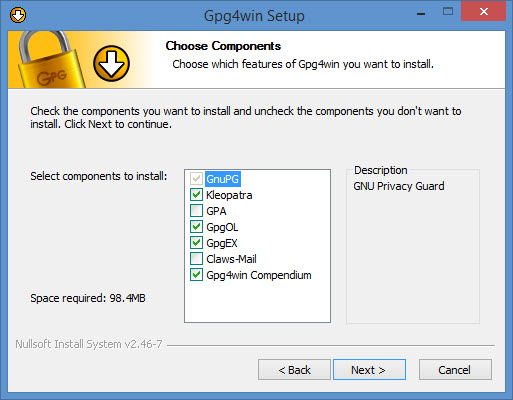

Exchanging public keys is done as a one-time out-of-band action before secure communication can occur. Remember this, without it the private key is useless and all information encrypted with its public analogue is lost.Įach party with which you will communicate will need to already know your public key in order to encrypt data intended to be decrypted by your private key. Once you hit “Create”, you will be prompted to set a passphrase on the key. Those who follow this blog religiously will make the connection that these are the same key generation algorithms used for SSL/TLS when dealing with encryption in-flight. While the program defaults to creating a very compatible 2048 bit RSA key, note that modern versions of Kleopatra are also capable of creating keys that leverage Elliptic Curve cryptography. The first task worth completing is creating a key pair. Opening Kleopatra presents us with the above window.

Please leave these defaults selected when installing for the purposes of this guide.
#Gpgwin cne windows#
GPG4WIN can be downloaded from Bundled with GPG is Kleopatra, a graphical certificate manager, GpgOL a tool for encrypting emails via GPG and GpgEX, an integration with Windows File Explorer for encrypting and decrypting files. GPG was created in order to provide an open source alternative to the expensive PGP. This company changed hands several times until ultimately acquired by Symantec in 2010. Zimmermann formed a company around this software, later selling it. Remember, at the time computer security was not as ubiquitous as it is today. We can think of it as the “Signal” private messenger of its era. This suite of tools was largely a political statement. In 1991, Phil Zimmermann (one of Newsweek’s "Net 50", the 50 most influential people on the Internet) authored PGP (Pretty Good Privacy). In order to properly discuss the history of GPG, we must set the scene. One very popular implementation of this standard is GPG4WIN which can be used on Windows systems to encrypt files at-rest. GPG can be thought of as a suite of individual tools, used for different purposes. One very popular tool for accomplishing this feat is GPG (GNU Privacy Guard), which is an open source standard for securing data storage. Encryption at-rest can be applied to an entire drive or value such as with Microsoft’s Bitlocker, or it can be more granularly applied to specific files. A key, passphrase, or both, is required to return the state of the data into something readable. Arbitrary data is treated as plaintext, and encrypted into ciphertext. This protects against physical theft, or an attacker who has already compromised the machine on which the data resides. In contrast, encryption at-rest encrypts data sitting on a hard drive. While encryption in-transit (also called in-flight) focuses on secure transmission via an insecure channel, both the sending and receiving endpoint have access to the information in the clear. However, equally worth understanding is encryption at-rest. Usually we focus on SSL/TLS and its role in encryption in-transit.


 0 kommentar(er)
0 kommentar(er)
